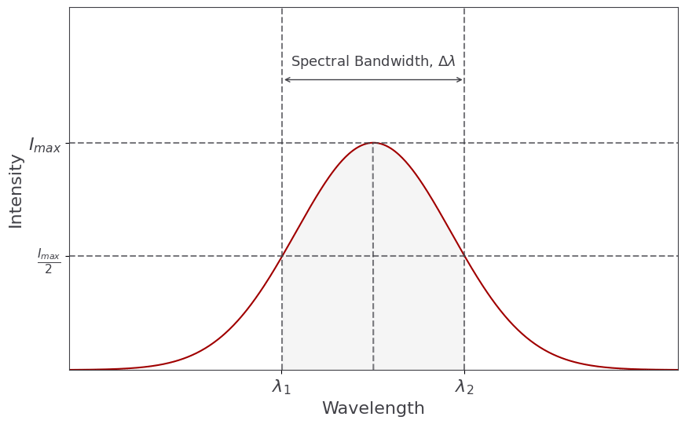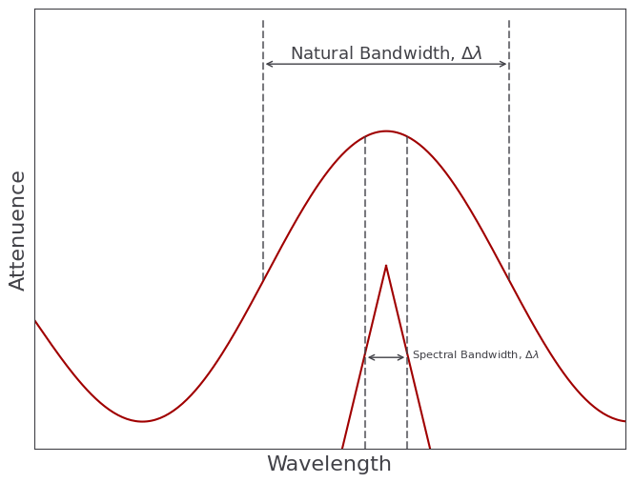What Is Spectral Bandwidth within UV-Vis Spectroscopy?
Spectral bandwidth is an important specification for UV-Vis spectrophotometers. Here you can learn why.
Spectral bandwidth is a crucial specification in UV-Vis spectrophotometers related to full width at half the maximum intensity (FWHM). The spectral bandwidth plays a significant role in influencing the accuracy, resolution, and overall quality of measurements derived from spectrophotometric analyses.
Caution:
Please note that there are two main types of UV-Vis spectrophotometers; monochromator-based instruments and diode-array instruments. It is crucial to understand the differences between them for accurate UV-Vis spectroscopy measurements. Learn more here.
Understanding Instrument Types: Monochromator-based vs. Diode-array Instruments
There are two types of spectrophotometers: Monochromator-based and Diode-array Instruments with corresponding definitions of spectral bandwidth. It is crucial to understand the differences between them for accurate UV-Vis spectroscopy measurements.
Monochromator-based UV-Vis Spectrophotometers
Monochromator-based instruments utilize a single detector and a monochromator to isolate individual wavelengths of light sequentially. The spectral bandwidth in these instruments is determined by the slit width of the monochromator and the dispersive element used.
Definition of Spectral Bandwidth for Monochromator-based UV-Vis Spectrophotometers
For monochromator-based UV-Vis spectrophotometers, the spectral bandwidth is defined as the width of the wavelength of light at half the maximum intensity of the light leaving the monochromator.
Definition:
The spectral bandwidth for monochromator-based UV-Vis spectrophotometers is defined as the width of the wavelength of light at half the maximum intensity of the light leaving the monochromator.
The spectral bandwidth in these instruments is determined by the physical slit-width of the monochromator and the dispersive element used. It plays a crucial role in influencing the accuracy, resolution, and overall quality of measurements, with a narrower spectral bandwidth offering enhanced resolution and peak separation.
The spectral bandwidth is a key factor that significantly influences the accuracy, resolution and overall quality of measurements obtained from spectrophotometric analyses. The spectral bandwidth of a monochromator based spectrophotometer is related to the physical slit-width and optical dispersion of the monochromator system.

Fig 1. Spectral bandwidth is related to full width at half the maximum intensity (FWHM) and plays a significant role in influencing the accuracy, resolution, and overall quality of measurements derived from spectrophotometric analyses.
Slit Width in Monochromator Systems
It is important as well to consider the slit width of the instrument. The slit width determines the width of the light beam (not to be confused with the wavelength of incoming light). A narrower slit width allows only a limited range of wavelengths to pass through, resulting in higher spectral resolution. This means that closely spaced spectral features can be resolved more effectively. However, a narrower slit also reduces the amount of light that enters the monochromator, potentially decreasing sensitivity. Additionally, it may require longer measurement times to achieve sufficient signal-to-noise ratio (SNR) due to the reduced light intensity reaching the detector. In contrast, a wider slit width provides higher signal intensity and faster data acquisition, but at the expense of spectral resolution, resulting in a diminished ability to distinguish fine features in the spectrum.
Spectral Bandwidth in Relation to Sampling Interval for Monochromators
The sampling interval used to digitize the spectrum for computer analysis affects the resolution of the measurements. If the sampling interval is larger than the spectral bandwidth, the resolution of the instrument will be reduced. Setting the sampling interval to be very small will improve resolution but also result in the file sizes being larger and recording a spectrum might take longer. The sampling interval should be set to be approximately equal to or slightly less than the spectral bandwidth. For example, in the case of a spectral bandwidth of 2 nm, a sampling interval of 2 nm or 1 nm can be used.
Diode-array UV-Vis Spectrophotometers
Diode-array instruments use an array of detectors, each responsible for a specific wavelength range. This allows for simultaneous measurement of all wavelengths, resulting in faster data acquisition. However, the spectral bandwidth in diode-array instruments is a physical property of a given detector. It is often fixed and determined by the design of the diode array.
Definition of Spectral Bandwidth for Diode-array UV-Vis Spectrophotometers
For diode-array UV-Vis spectrophotometers, the spectral bandwidth is defined as the wavelength range that each diode in the array can detect simultaneously.
Definition:
For diode-array UV-Vis spectrophotometers, the spectral bandwidth is defined as the wavelength range that each diode in the array can detect simultaneously.
The spectral bandwidth in these instruments is often fixed and is determined by the design and spacing of the diodes in the array. While diode-array instruments allow for rapid data acquisition by measuring all wavelengths simultaneously, the often fixed spectral bandwidth means that users have less flexibility in adjusting the resolution of their measurements. A smaller width between the diodes in the array will result in a smaller spectral bandwidth.
Slit Width in Diode-array Systems
A narrower slit width allows only a limited range of wavelengths to pass through, resulting in higher spectral resolution. This means that closely spaced spectral features can be resolved more effectively. However, a narrower slit also reduces the amount of light that enters the detector, potentially decreasing sensitivity. Additionally, it may require longer measurement times to achieve sufficient signal-to-noise ratio (SNR) due to the reduced light intensity reaching the detector. In contrast, a wider slit width provides higher signal intensity and faster data acquisition, but can increase the SNR, resulting in a diminished ability to distinguish fine features in the spectrum.
Spectral Bandwidth in Relation to Natural Bandwidth
Another critical aspect of the impact the spectral bandwidth has on measurement accuracy for both types of instruments is its relationship to the natural bandwidth of the absorbing substance. The natural bandwidth represents the width of the absorption band of the sample at half of its maximum absorption intensity. The accuracy of absorbance measurements depends on the ratio of the spectral bandwidth to the natural bandwidth. A lower spectral bandwidth/natural bandwidth ratio, such as 0.1 or less, corresponds to higher accuracy, with absorbance measurements achieving a precision level of 99.5% or better (see reference 4 for further details). This highlights the importance of having an appropriate spectral bandwidth based on the characteristics of the sample being analyzed.

Fig 2. Spectral bandwidth compared with a natural bandwidth of an absorbing sample.
Conclusion
Spectral bandwidth is an important specification in UV-Vis spectrophotometers, closely related to the full width at half the maximum intensity (FWHM). It has a profound influence on the accuracy, resolution, and overall quality of measurements obtained from spectrophotometric analyses. There are two primary types of UV-Vis spectrophotometers: monochromator-based and diode-array instruments. In monochromator-based spectrophotometers, the spectral bandwidth is determined by the slit width of the monochromator and the dispersive element used. On the other hand, diode-array instruments have a spectral bandwidth often fixed by the design of the diode array. Another essential aspect to consider is the relationship between the spectral bandwidth and the natural bandwidth of the absorbing substance. The accuracy of absorbance measurements is contingent on this ratio, emphasizing the need to select an appropriate spectral bandwidth based on the characteristics of the sample.
Tip:
Interested in how you can upgrade your existing UV-Vis spectrophotometers and easily streamline and automate your data analysis? Learn more here.
References
1. http://www.perseena.com/index/newsinfo/c_id/37/n_id/7.html
2. https://en.wikipedia.org/wiki/Spectrophotometry
3. https://en.wikipedia.org/wiki/Full_width_at_half_maximum
4. https://www.agilent.com/cs/library/slidepresentation/public/7%20fundamentals_of_UV.pdf